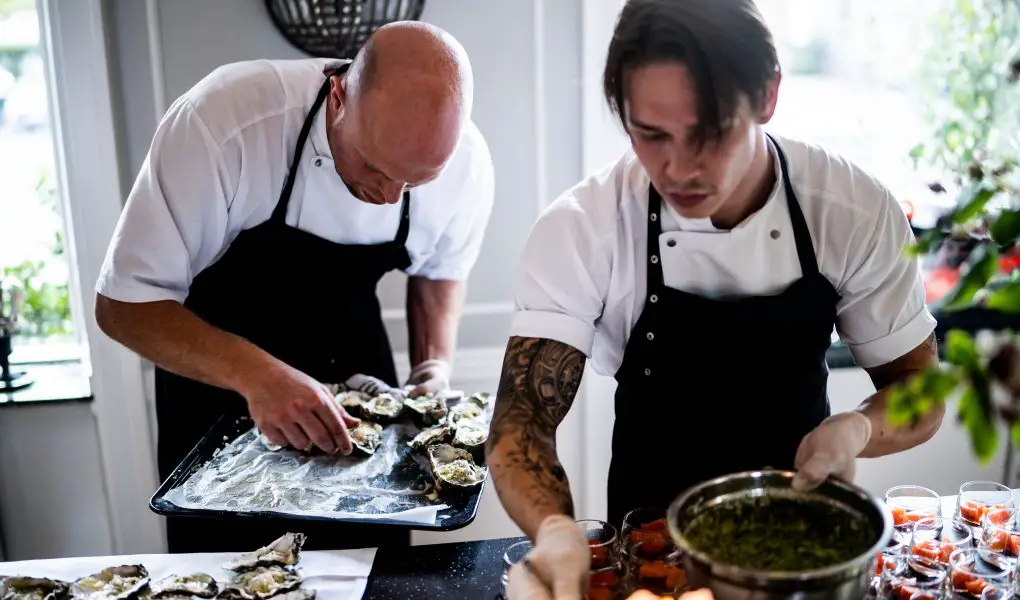As a chef, coming up with new and innovative menu concepts is key to staying ahead of the competition and keeping diners interested.
However, inspiration can be elusive, and it can be difficult to come up with truly unique ideas.
That’s where ChatGPT comes in – this AI-powered language model can be a valuable tool for chefs looking to develop fresh and exciting menu concepts.
What is ChatGPT?
ChatGPT is an artificial intelligence language model developed by OpenAI, based on the GPT-3.5 architecture. It’s capable of generating human-like text, completing sentences and paragraphs, and answering questions.
ChatGPT has been trained on a massive dataset of human-written text, which enables it to understand the nuances of language and generate text that is both grammatically correct and contextually relevant.
How Can Chefs Use ChatGPT?
Chefs can use ChatGPT to generate ideas for new menu items, refine existing recipes, and develop unique flavour combinations.
Here are some specific ways chefs can use ChatGPT to enhance their menu development process:
1. Generate New Menu Item Ideas.
Generating new menu item ideas can be a challenging task for chefs. With the help of ChatGPT, chefs can generate a wide range of ideas for new menu items, giving them a starting point for their menu development process.
ChatGPT can generate ideas based on various criteria such as flavour profiles, dietary restrictions, seasonal ingredients, or cuisine type.
For example, a chef can prompt ChatGPT to generate ideas for a new vegan entree that includes mushrooms and chickpeas. ChatGPT can then generate ideas such as a chickpea and mushroom curry, a roasted mushroom and chickpea salad, or a mushroom and chickpea burger.
Another way chefs can use ChatGPT to generate new menu ideas is by providing the AI model with a specific theme or concept.
For instance, a chef can ask ChatGPT to generate ideas for a new menu item that incorporates floral flavours or edible flowers.
ChatGPT can then generate ideas such as lavender-infused ice cream, rose petal sorbet, or a hibiscus flower cocktail.
One advantage of using ChatGPT to generate new menu item ideas is that it can suggest combinations and ingredients that chefs may not have considered before.
This can lead to innovative and unexpected dishes that set a restaurant apart from its competitors.
However, it’s important to note that while ChatGPT can generate a wide range of ideas, not all of them will be practical or suitable for a restaurant menu.
Chefs should evaluate ChatGPT-generated ideas critically, considering factors such as cost, availability of ingredients, and appeal to their target audience.
Overall, using ChatGPT to generate new menu item ideas can be a valuable tool for chefs looking to develop fresh and exciting menus.
By providing specific prompts and evaluating suggestions critically, chefs can use ChatGPT to spark their creativity and come up with unique and delicious menu concepts.
2. Refine Existing Recipes.
In addition to generating new menu item ideas, ChatGPT can also be used by chefs to refine and improve existing recipes. By inputting a recipe into ChatGPT, chefs can receive suggestions for ingredient substitutions, cooking techniques, and flavour combinations that can elevate the dish to the next level.
For example, if a chef is looking to improve a classic tomato sauce recipe, they can input the recipe into ChatGPT and prompt the AI model to suggest ways to enhance the flavour profile.
ChatGPT can suggest adding herbs such as basil and oregano, using San Marzano tomatoes for a sweeter flavour, or incorporating red wine for a richer taste.
ChatGPT can also suggest ingredient substitutions for recipes that may not be suitable for all diners, such as those with dietary restrictions. For instance, if a chef is looking to make a gluten-free version of a chocolate cake recipe, they can input the recipe into ChatGPT and prompt the AI model to suggest gluten-free flour substitutes or alternative binding agents.
Another way chefs can use ChatGPT to refine existing recipes is by inputting a recipe and prompting the AI model to suggest ways to make the dish healthier. ChatGPT can suggest ingredient substitutions, such as using low-fat dairy products or replacing butter with vegetable oil, or suggest alternative cooking methods, such as baking instead of frying.
By using ChatGPT to refine existing recipes, chefs can enhance the flavour profile and nutritional value of their dishes, making them more appealing to diners.
It can also help chefs to accommodate the dietary needs and preferences of their guests, ensuring that everyone can enjoy their meal at the restaurant.
However, it’s important to note that ChatGPT is not a substitute for a chef’s expertise and experience. Chefs should evaluate ChatGPT-generated suggestions critically and use their own judgment to determine which suggestions are worth implementing in their recipes.
Overall, using ChatGPT to refine existing recipes can be a valuable tool for chefs looking to improve the quality and nutritional value of their menu items. By inputting a recipe and prompting the AI model to suggest enhancements, chefs can create dishes that are more flavourful, nutritious, and appealing to diners.
Using ChatGPT to Create Awesome Food Blog Content for Your Restaurant
3. Develop Unique Flavour Combinations.
One of the most exciting aspects of menu development is creating unique flavour combinations that surprise and delight diners.
ChatGPT can be a valuable tool for chefs looking to develop new and interesting flavour combinations by suggesting ingredient pairings that they may not have considered before.
For example, a chef may prompt ChatGPT to suggest flavour combinations that pair well with strawberries. ChatGPT may suggest combining strawberries with balsamic vinegar, basil, or goat cheese for a sweet and savoury flavour profile.
ChatGPT can also suggest flavour combinations based on specific cuisines or dietary restrictions. For instance, if a chef is looking to develop a vegan dish with a Middle Eastern flavour profile, they can prompt ChatGPT to suggest ingredient pairings such as chickpeas and tahini or roasted eggplant and pomegranate molasses.
Another way chefs can use ChatGPT to develop unique flavour combinations is by inputting a list of ingredients and prompting the AI model to suggest ways to combine them for maximum flavour impact. ChatGPT may suggest using techniques such as roasting, caramelizing, or pickling to enhance the flavour profile of the ingredients.
By using ChatGPT to develop unique flavour combinations, chefs can create dishes that stand out from the competition and keep diners coming back for more.
However, it’s important for chefs to evaluate ChatGPT-generated suggestions critically, considering factors such as cost, feasibility, and appeal to their target audience.
Overall, ChatGPT can be a valuable tool for chefs looking to develop unique and delicious flavour combinations.
By prompting the AI model to suggest ingredient pairings and preparation techniques, chefs can create dishes that surprise and delight diners, making their restaurant stand out in a crowded market.
4. Create Menu Descriptions.
Creating compelling menu descriptions is essential for attracting and enticing diners to try new menu items. With ChatGPT, chefs can generate descriptive and enticing menu item descriptions that accurately reflect the dish’s flavour profile and ingredients.
By inputting a dish’s main ingredients, ChatGPT can suggest adjectives, descriptive phrases, and culinary terms that chefs can use to create a mouthwatering description. For instance, if a chef is creating a new steak dish, they can input “steak” into ChatGPT and receive suggestions such as “juicy”, “grilled to perfection”, “tender”, and “served with a rich red wine sauce”.
ChatGPT can also suggest creative names for menu items that help to convey the dish’s unique flavour profile or preparation method.
For example, if a chef is creating a new sushi roll with spicy tuna, they can input “spicy tuna sushi roll” into ChatGPT and receive suggestions such as “Firecracker Roll” or “Spice Bomb Roll” that are more creative and memorable.
Another way chefs can use ChatGPT to create menu descriptions is by inputting a dish’s main ingredients and prompting the AI model to suggest flavour profiles and culinary techniques that can be used to create an enticing description. ChatGPT can suggest phrases such as “bursting with flavour”, “perfectly balanced”, or “cooked to perfection using a sous-vide method”.
By using ChatGPT to create menu descriptions, chefs can ensure that their dishes are accurately represented and enticing to diners.
However, it’s important to note that ChatGPT-generated descriptions should be edited and customized to fit the restaurant’s brand voice and target audience.
Overall, using ChatGPT to create menu descriptions can save time and help chefs to create mouthwatering descriptions that accurately reflect their dishes’ flavour profile and preparation method.
With creative and enticing descriptions, restaurants can entice diners to try new menu items and increase sales.
Tips for Using ChatGPT in Menu Development.
While ChatGPT can be a powerful tool for chefs, it’s important to use it strategically to get the best results.
Here are some tips for using ChatGPT effectively in menu development:
1. Provide Clear and Specific Prompts.
When using ChatGPT to generate ideas or refine recipes, it’s important to provide clear and specific prompts. This helps ensure that the AI model understands what you’re looking for and generates relevant ideas. Vague or overly broad prompts may result in irrelevant or unhelpful suggestions.
2. Use Multiple Prompts.
To generate a range of ideas and options, it’s a good idea to use multiple prompts when working with ChatGPT. This can help ensure that the AI model explores a range of possibilities and generates a diverse set of suggestions.
3. Evaluate Suggestions Critically.
While ChatGPT can generate a wide range of ideas and suggestions, not all of them will be winners. It’s important for chefs to evaluate suggestions critically and use their own expertise and judgement to determine which ideas are worth pursuing.
Chefs should consider factors such as feasibility, cost, and appeal to their target audience when evaluating ChatGPT-generated ideas.
4. Incorporate Human Expertise.
While ChatGPT can be a valuable tool, it’s important for chefs to remember that it’s just one piece of the menu development puzzle. Human expertise and creativity are still essential for developing truly unique and delicious menu items.
Chefs should use ChatGPT as a starting point or source of inspiration, but ultimately rely on their own skills and experience to create dishes that are both innovative and delicious.
5. Experiment and Iterate.
Menu development is an ongoing process, and chefs should be willing to experiment and iterate on their ideas.
ChatGPT can help generate new and interesting concepts, but chefs should be willing to try new ingredients, techniques, and flavour combinations to create dishes that truly stand out.
Conclusion.
As the restaurant industry becomes increasingly competitive, it’s more important than ever for chefs to develop unique and innovative menu concepts that keep diners coming back for more.
ChatGPT can be a valuable tool for chefs looking to generate fresh ideas, refine existing recipes, and develop unique flavour combinations.
By using ChatGPT strategically and incorporating their own expertise and creativity, chefs can create menus that set their restaurant apart and keep diners excited and engaged.




